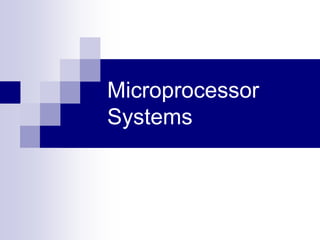
Mikroprosessor system
- 2. Microprocessor Systems Definition: A complete electronic system built around the microprocessor to support the microprocessor operation. May consist of CPU, memory, I/O (disk drives, keyboard, mouse), system bus, and supporting circuitry. CPU as the “brain” – controls actions of all components.
- 3. Microprocessor System - PC ROM Keyboard Mouse HDD Floppy RAM CD-ROM Supporting CircuitryCPU
- 4. Microprocessor System - Calculator Keypad Memory Power Supply LCD DisplayCPU
- 5. System Bus A µP-based system consists of many components: CPU. Memory. I/O: disk drives, keyboard, mouse. System Bus. Supporting circuitry. All components communicate using System Bus.
- 6. System Bus Communication “highway” for all components. Contains: Data lines. Address lines. Control lines: regulate information transfer, interrupts, error signals.
- 7. Block Diagram Parallel I/O Serial I/O Interrupt Circuit Timing CPU Memory System Bus
- 8. The CPU “Master” of all components. Job: Get instructions from memory. Execute instructions. Perform calculations (may use math co- processor). Control bus operations. CPU
- 9. The CPU CPU consists of: ALU (Arithmetic/Logic Unit): Performs arithmetic/ logic computations. CU (Control Unit): Responsible to retrieve instructions, analyze, then execute. Registers: Fast internal storage. Used to temporarily store addresses, data, processor status.
- 10. Memory Stores instructions and data for CPU. Each memory location given unique address. CPU refers to address to access. Types: Read-Only Memory (ROM). Random-Access Memory (RAM). Non-Volatile Memory (NVM). Memory
- 11. RAM, ROM and NVM Memory NVM RAM ROM Stores start-up instructions and critical system data and variables. Stores general data and applications
- 12. ROM Read-Only Memory: Data can be read, but cannot be written (read-only). Contents stay without power (non-volatile). Usually contains basic start-up instructions, data. Contents hard-wired during manufacturing. Newer versions can be reprogrammed: PROM: Fuse & anti-fuse. EPROM: UV light. EEPROM: Electrical current.
- 13. ROM Examples Quartz Window EEPROM Programmer EPROM
- 14. NVM Non-Volatile Memory Contents can be read and written. Contents stay without power (non-volatile). Advantages: Keeps memory even with no power. Data is protected against blackouts. Rewriteable. Disadvantages: Slower than RAM.
- 15. RAM Random Access Memory. Contents can be read and written. Loses data without electrical power (volatile). Advantages: Programs can be loaded and reloaded. Larger capacity. Disadvantages: Requires power, refresh cycles.
- 16. RAM vs. ROM Computer is turned on CPU looks for instructions from memory RAM is still empty because the computer has just been started. CPU loads instructions from ROM.
- 17. RAM vs. ROM ROM only has basic functions to start the computer. RAM loads more advanced functions, such as the OS.
- 18. Timing Circuit Timing Synchronizes all components in the system. All components refer to the clock timing for operations. Generates square waves at constant intervals. Crystal oscillator + timing circuitry. Higher clock speed allow computers to function faster.
- 20. Clock Signal T T T
- 21. Clock Signal vs. Processing Speed Instruction CLR.W D7 takes 4 cycles to complete. time Slow clock speed Fast clock speed
- 22. I/O Input/Output. Connects µP with external devices: Add functionality to µP. Interfaces with µP using ports. Examples: Keyboard. Mouse. Display monitor.
- 23. How do ports connect to system bus? Built into board Using card slots.
- 24. Serial I/O Sends/receives data sequentially across 2 channels. One for receive, one for transmit. Connects using serial ports. Advantages: Less crosstalk. Disadvantages: Slow. Needs special circuit to convert back to parallel (UART – Universal Asynchronous Receiver/Transmitter). Serial I/O
- 25. Serial Port
- 26. Parallel I/O Sends/receives data across multiple lines at one time. Connects using parallel ports. Advantages: Faster than serial. Simpler circuits – doesn’t need UART. Disadvantages: Crosstalk. Parallel I/O
- 27. Parallel Port
- 28. Parallel vs. Serial I/O 1011011010101010011010101010100011101100101 1011011010101010011010101010100011101100101 1011011010101010011010101010100011101100101 1011011010101010011010101010100011101100101 Serial Port Parallel Port 1011011010101010011010101010100011101100101 Receive Transmit . . Receive/Transmit Receive/Transmit Receive/Transmit
- 29. UART UART 1 0 0 1 1001 UART 1 0 0 1 1001 To System BusFrom Device From System BusTo Device
- 30. Interrupt Circuit Allows other components to “interrupt” normal CPU operation: Prioritize CPU tasks. Error detection mechanism. Accept inputs from devices – keystroke, mouse press. Depends on task importance: Important tasks given higher interrupts. Less important tasks queued. CPU keeps track of current interrupt level. Interrupt Circuit
- 31. How Interrupts Work CPU Device 1. CPU is performing tasks normally. 2. Device has more important task that requires immediate attention. 3. Device requests interrupt from CPU. 4. CPU saves its current task so that it can return to it when the interrupt completes. 5. CPU services the interrupt. 6. CPU reloads saved task, and resumes normally.